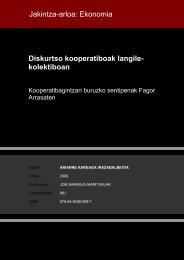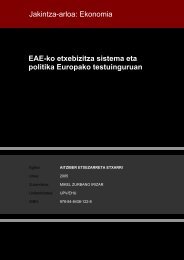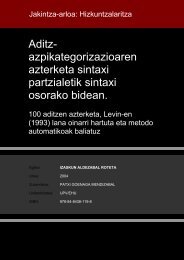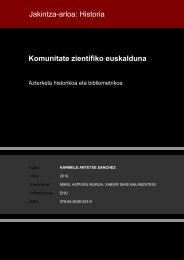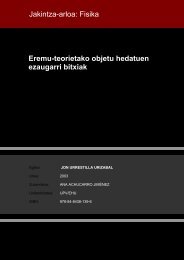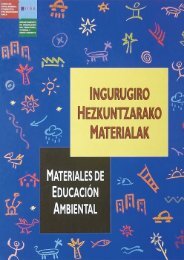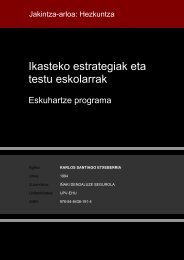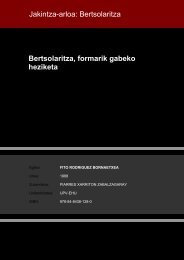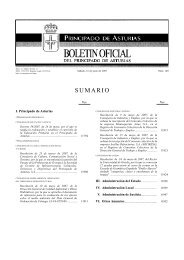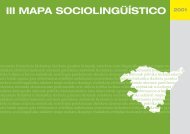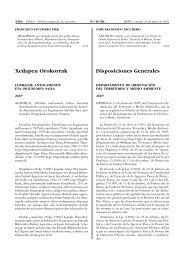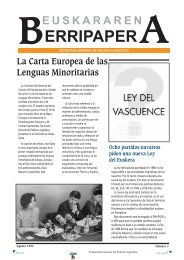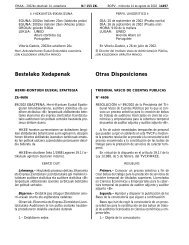Ikasle helduen ikas- estiloak eta ikas- estrategiak euskararen ...
Ikasle helduen ikas- estiloak eta ikas- estrategiak euskararen ...
Ikasle helduen ikas- estiloak eta ikas- estrategiak euskararen ...
You also want an ePaper? Increase the reach of your titles
YUMPU automatically turns print PDFs into web optimized ePapers that Google loves.
(Technical Report 13). Honolulu: Second Language Teaching & Curriculum<br />
Center, University of Hawai.<br />
317<br />
Chamot, A., Keathleym, C., Barnhardt, S., El-Dinary, P., Nagano, K. <strong>eta</strong> Newman,<br />
C. (1996). Learning strategies in elementary language immersion programs: final<br />
report. Washington: Language Research Projects, Georgetown University.<br />
Chamot, A., O´Malley, J.M., Küpper, L. <strong>eta</strong> Impink-Hernandez, M.V. (1987). A<br />
Study of Learning Strategies in Foreign Language Instruction: First Year Report.<br />
Rosslyn, Va., Interstate Research Associates.<br />
Chamot, A., O’Malley, J. <strong>eta</strong> Küpper, L. . (1992). Building Bridges. Boston: Heinle<br />
& Heinle Publishers.<br />
Chamot, A., O’Malley, J. <strong>eta</strong> Küpper, L., Impink-Hernández, M.V. (1987). A study<br />
of learning strategies in foreign language instruction: first year report.<br />
Washington: InterAmerica Research Associates.<br />
Chandler, J., Lizotte, R <strong>eta</strong> Rowe, M. (1998). “Adapting Teaching Methods to<br />
Learners’ Preferences, Strategies, and Needs”. College ESL, 8/1: 48-69.<br />
Chapelle, C. <strong>eta</strong> Robert, C. (1986). “Ambiguity tolerance and field independence a<br />
predictor of proficiency in English as a second language”. Language Learning,<br />
36:27-45.<br />
Chaudron, C. (1983). “Research o m<strong>eta</strong>linguistic judgements: a review of theory,<br />
methods, and results”. Language Learning, 33/3:343-377.<br />
Chaudron, C. (1988). Second Language Classrroms: Research on Teaching and<br />
Learning. Cambridge: Cambridge University Press.<br />
Chesterfield, R. <strong>eta</strong> Chesterfield, K.B. (1985). “Natural order in children’s use of<br />
second language learning strategies”. Applied Linguistics, 6 /1: 45-59.<br />
Chouinard, R. (1994). “L’effet des croyanes et des attentes sur la motivation scolaire”.<br />
La revue de l’AQEFLS, 16/1 <strong>eta</strong> 16/2: 35-51.<br />
Clariana, R.B. <strong>eta</strong> Smith, L. (1988). Learning Style Shifts in Computer-Assisted<br />
Instructional Settings. Ann Arbor. Michigan. ERIC. ED 295796.<br />
Clarke, D. F. (1991): “The negotiated syllabus: What is it and how is it likely to<br />
work?”. Applied Linguistics 12/1.<br />
Claxton, C.S. <strong>eta</strong> Murrell, P.H. (1978). Learning Styles: Implications for Improving<br />
Educational Practices. Washington: AAHE-ERIC Higher Education Report, 4.<br />
Claxton, C.S. <strong>eta</strong> Ralston, Y. (1978). “Learning Styles: the Impact on Teaching and<br />
Administration”. AAHE-ERIC Higher Education, Research Report, 10. (American<br />
Association for Higher Education, Washington, D.C.)<br />
Cohen, A.D. (1990). Language learning: insights for learners, teachers, and<br />
researchers. New York: Newbury House / Harper & Row.<br />
Cohen, A.D. (1996). “Verbal reports as source of insight into second language learner<br />
strategies”. Applied Language Learning 7 /1,2: 5-24.<br />
Cohen, A.D. (1998). Strategies in Learning and Using a Second Language. New York:<br />
Longman.



